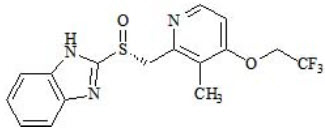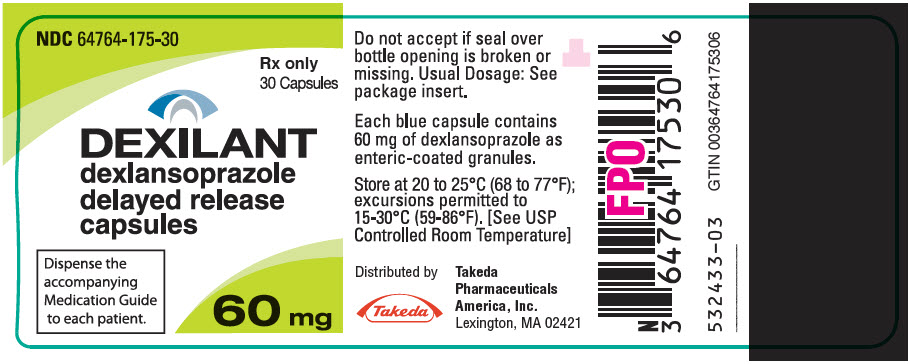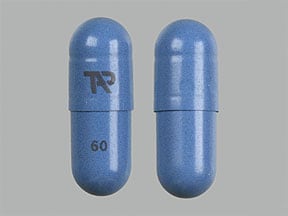Dexilant
Generic name: dexlansoprazole
Drug class: Proton pump inhibitors
Medically reviewed by A Ras MD.
What is Dexilant?
Dexilant is a prescription medicine called a proton pump inhibitor (PPI). Dexilant reduces the amount of acid in your stomach.
Dexilant is used in people 12 years of age and older for up to 8 weeks to heal acid-related damage to the lining of the esophagus (called erosive esophagitis or EE), for up to 6 months in adults and up to 16 weeks in children 12 to 17 years of age to continue healing of erosive esophagitis and relief of heartburn, for 4 weeks to treat heartburn related to gastroesophageal reflux disease (GERD)
GERD happens when acid from your stomach enters the tube (esophagus) that connects your mouth to your stomach. This may cause a burning feeling in your chest or throat, sour taste or burping.
It is not known if Dexilant is safe and effective in children under 12 years of age.
Dexilant is not effective for symptoms of GERD in children under 1 year of age.
Description
The active ingredient in DEXILANT (dexlansoprazole) delayed-release capsules, a proton pump inhibitor, is (+)-2-[(R)-{[3-methyl-4-(2,2,2-trifluoroethoxy)pyridin-2-yl] methyl} sulfinyl]-1H-benzimidazole, a compound that inhibits gastric acid secretion. Dexlansoprazole is the R-enantiomer of lansoprazole (a racemic mixture of the R– and S-enantiomers). Its empirical formula is: C16H14F3N3O2S, with a molecular weight of 369.36.
Dexlansoprazole has the following chemical structure:

Dexlansoprazole is a white to nearly white crystalline powder which melts with decomposition at 140°C. Dexlansoprazole is freely soluble in dimethylformamide, methanol, dichloromethane, ethanol, and ethyl acetate; and soluble in acetonitrile; slightly soluble in ether; and very slightly soluble in water; and practically insoluble in hexane.
Dexlansoprazole is stable when exposed to light. Dexlansoprazole is more stable in neutral and alkaline conditions than acidic conditions.
Dexlansoprazole is supplied for oral administration as a dual delayed-release formulation in capsules. The capsules contain dexlansoprazole in a mixture of two types of enteric-coated granules with different pH-dependent dissolution profiles .
DEXILANT delayed-release capsules are available in two dosage strengths: 30 and 60 mg, per capsule. Each capsule contains enteric-coated granules consisting of dexlansoprazole (active ingredient) and the following inactive ingredients: sugar spheres, magnesium carbonate, sucrose, low-substituted hydroxypropyl cellulose, titanium dioxide, hydroxypropyl cellulose, hypromellose 2910, talc, methacrylic acid copolymers, polyethylene glycol 8000, triethyl citrate, polysorbate 80, and colloidal silicon dioxide. The components of the capsule shell include the following inactive ingredients: hypromellose, carrageenan and potassium chloride. Based on the capsule shell color, blue contains FD&C Blue (or FD&C Blue No. 2 aluminum lake); gray contains black ferric oxide; and both contain titanium dioxide.
Mechanism of Action
Dexlansoprazole belongs to a class of antisecretory compounds, the substituted benzimidazoles, that suppress gastric acid secretion by specific inhibition of the (H+, K+)-ATPase at the secretory surface of the gastric parietal cell. Because this enzyme is regarded as the acid (proton) pump within the parietal cell, dexlansoprazole has been characterized as a gastric proton-pump inhibitor, in that it blocks the final step of acid production.
What is the most important information I should know about Dexilant?
Dexilant may help your acid-related symptoms, but you could still have serious stomach problems. Talk with your doctor.
Dexilant can cause serious side effects, including:
- A type of kidney problem (acute interstitial nephritis). Some people who take proton pump inhibitor (PPI) medicines, including Dexilant, may develop a kidney problem called acute interstitial nephritis, that can happen at any time during treatment with PPI medicines. Call your doctor right away if you have a decrease in the amount that you urinate or if you have blood in your urine.
- Diarrhea. Dexilant may increase your risk of getting severe diarrhea. This diarrhea may be caused by an infection (Clostridium difficile) in your intestines. Call your doctor right away if you have watery stool, stomach pain, and fever that does not go away.
- Bone fractures. People who take multiple daily doses of PPI medicines for a long period of time (a year or longer) may have an increased risk of fractures of the hip, wrist or spine. You should take Dexilant exactly as prescribed, at the lowest dose possible for your treatment and for the shortest time needed. Talk to your doctor about your risk of bone fracture if you take Dexilant.
- Certain types of lupus erythematosus. Lupus erythematosus is an autoimmune disorder (the body’s immune cells attack other cells or organs in the body). Some people who take PPI medicines may develop certain types of lupus erythematosus or have worsening of the lupus they already have. Call your doctor right away if you have new or worsening joint pain or a rash on your cheeks or arms that gets worse in the sun.
Dexilant can have other serious side effects. See “What are the possible side effects of Dexilant?” below.
Who should not take Dexilant?
Do not take Dexilant if you:
- are allergic to dexlansoprazole or any of the other ingredients in Dexilant. See the end of this guide for a complete list of ingredients in Dexilant.
- are taking a medicine that contains rilpivirine (Edurant, Complera) used to treat HIV-1 (Human Immunodeficiency Virus)
What should I tell my healthcare provider before taking Dexilant?
Before you take Dexilant, tell your doctor if you:
- have been told that you have low magnesium levels in your blood
- have liver problems
- have any other medical conditions
- are pregnant or plan to become pregnant. Dexilant may harm your unborn baby. Talk to your doctor about the possible risks to an unborn baby if Dexilant is taken during pregnancy.
- are breastfeeding or plan to breastfeed. It is not known if Dexilant passes into your breast milk or if it will affect your baby or your breast milk. Talk to your doctor about the best way to feed your baby if you take Dexilant.
Tell your doctor about all the medicines you take, including prescription and over-the-counter medicines, vitamins, and herbal supplements. Dexilant may affect how other medicines work, and other medicines may affect how Dexilant works. Especially tell your doctor if you take methotrexate (Otrexup, Rasuvo, Trexall).
Know the medicines that you take. Keep a list of them to show your doctor and pharmacist when you get a new medicine.
How should I take Dexilant?
- Take Dexilant exactly as prescribed by your doctor.
- Do not change your dose or stop taking Dexilant without talking to your doctor first.
- Take Dexilant with or without food.
- Swallow Dexilant whole. Do not chew the capsules or the granules that are in the capsules.
- If you have trouble swallowing a whole capsule, you can open the capsule and take the contents in applesauce. See the “Instructions for use” at the end of this guide for instructions on how to take Dexilant with applesauce.
- See the “Instructions for use” at the end of this guide for instructions on how to mix and give Dexilant with water using an oral syringe or through a nasogastric tube.
- If you miss a dose of Dexilant, take it as soon as you remember. If it is almost time for your next dose, do not take the missed dose. Take your next dose at your regular time. Do not take 2 doses at the same time to make up for the missed dose.
- If you take too much Dexilant, call your doctor or your poison control center at 1-800-222-1222 right away or go to the nearest hospital emergency room.
What are the possible side effects of Dexilant?
Dexilant may cause serious side effects, including:
- See “What is the most important information I should know about Dexilant?” above.
- Vitamin B12 deficiency. Dexilant reduces the amount of acid in your stomach. Stomach acid is needed to absorb Vitamin B12 properly. Talk with your doctor about the possibility of Vitamin B12 deficiency if you have been on Dexilant for a long time (more than 3 years).
- Low magnesium levels in your body. This problem can be serious. Low magnesium can happen in some people who take a PPI medicine for at least 3 months. If low magnesium levels happen, it is usually after a year of treatment. You may or may not have symptoms of low magnesium.
- Tell your doctor right away if you develop any of these symptoms:
- seizures
- dizziness
- abnormal or fast heartbeat
- jitteriness
- jerking movements or shaking (tremors)
- muscle weakness
- spasms of the hands and feet
- cramps or muscle aches
- spasm of the voice box
- Your doctor may check the level of magnesium in your body before you start taking Dexilant, or during treatment, if you will be taking Dexilant for a long period of time.
- Tell your doctor right away if you develop any of these symptoms:
- Stomach growths (fundic gland polyps). People who take PPI medicines for a long time have an increased risk of developing a certain type of stomach growth called fundic gland polyps, especially after taking PPI medicines for more than 1 year.
The most common side effects of Dexilant in adults include:
The most common side effects of Dexilant in children 12 to 17 years of age include:
- headache
- stomach pain
- diarrhea
- pain or swelling (inflammation) in your mouth, nose or throat
Other side effects:
- Serious allergic reactions. Tell your doctor if you get any of the following symptoms with Dexilant:
- rash
- face swelling
- throat tightness
- difficulty breathing
Your doctor may stop Dexilant if these symptoms happen.
Tell your doctor if you have any side effect that bothers you or that does not go away.
These are not all the possible side effects of Dexilant. For more information, ask your doctor or pharmacist.
Call your doctor for medical advice about side effects. You may report side effects to FDA at 1-800-FDA-1088.
General information about the safe and effective use of Dexilant
Medicines are sometimes prescribed for purposes other than those listed in a Medication Guide. Do not use Dexilant for a condition for which it was not prescribed. Do not give Dexilant to other people, even if they have the same symptoms you have. It may harm them.
This Medication Guide summarizes the most important information about Dexilant. If you would like more information, talk with your doctor. You can ask your doctor or pharmacist for information about Dexilant that is written for health professionals.
For more information, go to www.Dexilant.com or call 1-877-825-3327.
How should I store Dexilant?
- Store Dexilant at room temperature between 68°F to 77°F (20°C to 25°C).
Keep Dexilant and all medicines out of the reach of children.
What are the ingredients in Dexilant?
Active ingredient: dexlansoprazole.
Inactive ingredients: sugar spheres, magnesium carbonate, sucrose, low-substituted hydroxypropyl cellulose, titanium dioxide, hydroxypropyl cellulose, hypromellose 2910, talc, methacrylic acid copolymers, polyethylene glycol 8000, triethyl citrate, polysorbate 80, and colloidal silicon dioxide.
The capsule shell is made of hypromellose, carrageenan and potassium chloride. Based on the capsule shell color, blue contains FD&C Blue No. 2 aluminum lake; gray contains black ferric oxide; and both contain titanium dioxide.
Instructions for use
Taking Dexilant with applesauce:
- Place 1 tablespoon of applesauce into a clean container.
- Carefully open the capsule and sprinkle the granules onto the applesauce.
- Swallow the applesauce and granules right away. Do not chew the granules. Do not save the applesauce and granules for later use.
Giving Dexilant with water using an oral syringe:
- Place 20 mL of water into a clean container.
- Carefully open the capsule and empty the granules into the container of water.
- Use an oral syringe to draw up the water and granule mixture.
- Gently swirl the oral syringe to keep the granules from settling.
- Place the tip of the oral syringe in your mouth. Give the medicine right away. Do not save the water and granule mixture for later use.
- Refill the syringe with 10 mL of water and swirl gently. Place the tip of the oral syringe in your mouth and give the medicine that is left in the syringe.
- Repeat step 6.
Giving Dexilant with water through a nasogastric tube (NG tube):
For people who have an NG tube that is size 16 French or larger, Dexilant may be given as follows:
- Place 20 mL of water into a clean container.
- Carefully open the capsule and empty the granules into the container of water.
- Use a 60 mL catheter-tip syringe to draw up the water and granule mixture.
- Gently swirl the catheter-tip syringe to keep the granules from settling.
- Connect the catheter-tip syringe to the NG tube.
- Give the mixture right away through the NG tube that goes into the stomach. Do not save the water and granule mixture for later use.
- Refill the catheter-tip syringe with 10 mL of water and swirl gently. Flush the NG tube with the water.
- Repeat step 7.
Label
PRINCIPAL DISPLAY PANEL – 60 MG CAPSULE BOTTLE LABEL
- NDC 64764-175-30
- Rx only
30 Capsules - DEXILANT
dexlansoprazole
delayed release
capsules - Dispense the
accompanying
Medication Guide
to each patient. - 60 mg


SRC: NLM .
